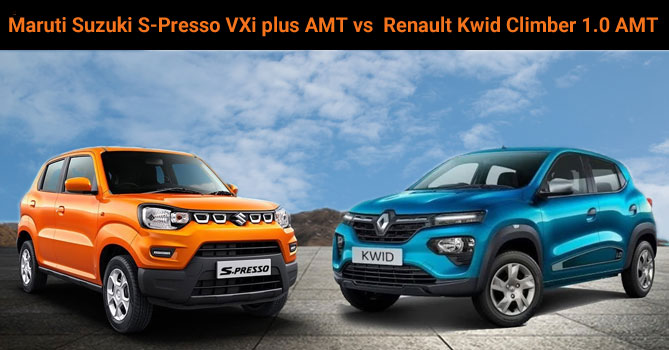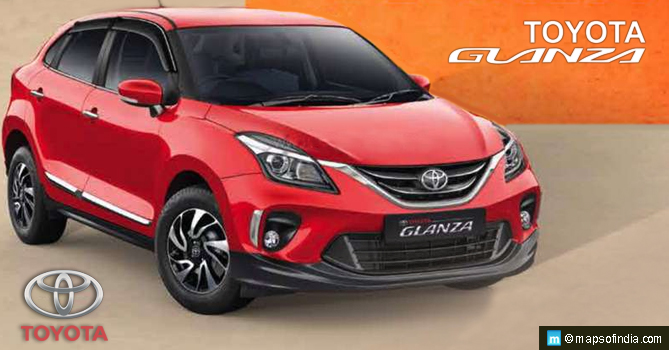
Maruti Suzuki S-Presso VXi plus AMT vs Renault Kwid Climber 1.0 AMT – Safety
The Renault Kwid and Maruti S-Presso both come with dual airbags, ABS with EBD, parking sensors, seatbelt warning lights for driver and front passenger, and speed alert. However, while the S-Presso has dual airbags as standard across all variants; the Kwid gets these only in its 1.0 Litre and AMT variants. It also comes with a rear camera of standard build and quality and exists only as a feature rather than an enhancement.
Trims and other issues
In the S-Presso, the rear wheel cladding is absent, leaving the bare chassis and fuel hose exposed in that area. The Kwid has no carpeting in the boot area revealing the bare metal of the rear wheel well and the housing of the shock-absorbers.
The Kwid also has three-wheel lug nuts instead of the standard four in small cars. This poses a challenge to those wishing to upgrade to more significant or better-looking alloy wheels since three-holed ones are rare to find.
Seating and Comfort
Both cars have a fixed steering wheel that comes without any tilt or telescopic adjustments. The Kwid’s steering wheel is set at an optimum height considering the thighs of an average passenger. In contrast, the S-Presso’s is a little lower than usual and can affect the comfort level of tall passengers.
Considering that they are both small cars, the interior space is sufficient for average-sized passengers. In the case of Kwid, people of a height between 5 feet 4 inches and 5 feet 8 inches will easily slip in, but with some discomfort to those seated at the back. Tall passengers may also need to duck to be able to get in and might feel a little squashed inside owing to the limited leg-space, especially at the back.
The S-Presso’s seats are better placed with increased height and roof clearance so that getting in and out of it is more comfortable compared to the Kwid. Under thigh support, knee room and headroom are also slightly better on the S-Presso, and one can see where it begins to acquire more points than the other. This makes the S-Presso a better option for long-distance travel, and less fatigue caused by it.
It also gets a bigger greenhouse that makes it feel airier and visually comforting on the inside. Despite having a bigger cabin-volume, the air-conditioning of the S-Presso cools it faster than that of the Kwid being more effective than the latter.
Boot capacity is almost the same for both the cars at around 270 litres. The Kwid’s boot is slightly better shaped owing to its smaller loading flap, packs more stuff without concern for toppling. The S-Presso has a bigger flap, and due to its insufficient overall width, offers less luggage holding in the same amount of space as its competitor.
Power and Transmission
Both cars come with 1.0-litre three-cylinder petrol engines producing similar amounts of power and torque. Both powertrains are mated to five-speed AMT units, and though that would imply similar driving experiences, it would not be accurate.
Shifting into D will expose the lack of instant power in the Kwid, and one would need to put more than the average amount of pressure on the pedal to get the car to move. All this is despite the company provided “creep” function that allows semi-automatic and automatic gearboxes to propel the vehicle forward on its own upon shifting into Drive. While moving, the accelerator foot need not be heavy as the car is relatively responsive to partial pressure on the go.
The car upshifts quickly on its own to regulate fuel usage. Pushing harder would strain the engine more than the output it will provide and pick up speed will take time. Refinement is of standard quality, and the engine sounds throaty and strained at higher RPMs. Downshift time is stretched and overtakes are not the most effortless due to the lack of power.
The S-Presso’s powertrain setup feels much better tuned and is far more responsive than the Kwid’s. The slightest nudge on the throttle makes the car lunge forward with delight, and extra caution is advised while moving in traffic. Refinement is noticeably better than the Kwid, and when moving from a standstill, the S-Presso tends to spin its wheels before taking off especially when parked on a low-friction surface such as dirt or loose gravel.
In summary, the S-Presso has a better gearbox and drive function than the Kwid. Its surprisingly peppy and responsive powertrain combination scrubs the slow-shifting image that most AMT setups have.
Suspension
Suspension on the Kwid is soft and does a great job of soaking up bumps and irregularities in the road. Sudden or sharp bumps will, however, make their presence noted since the suspension travel would be complete just as quickly as engaged and a distinct “thud” can be heard in such cases. The soft suspension also lowers the ground clearance of a loaded car and the tallest of speed-breakers are suddenly in the reach of the underbelly, which it announces with an audible “Scrape”.
On the S-Presso, the suspension setup is set to be stiffer, which makes for a jerkier ride quality when compared to the Kwid. Bumpy stretches of road will cause the passengers to be tossed a few times, and road irregularities would be distinctly felt and heard through the floor at all times.
One wouldn’t call the S-Presso uncomfortable, just less suited to rough rides, when compared to the Kwid.
Related Link:
Maruti Suzuki S-Presso VXi plus AMT vs Renault Kwid Climber 1.0 AMT – Part 1





